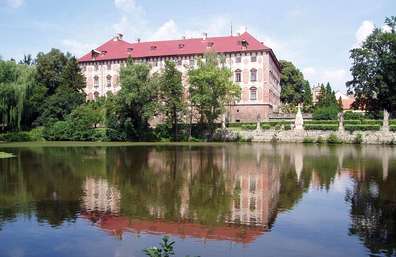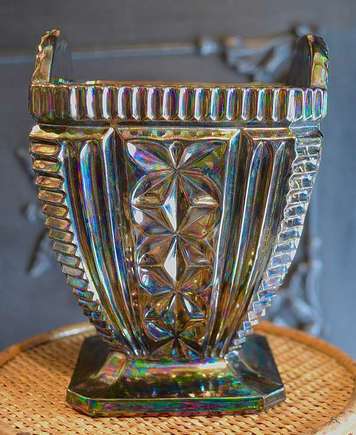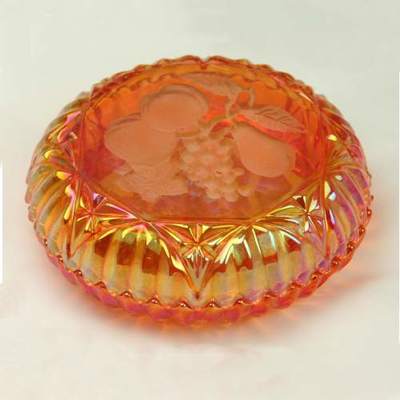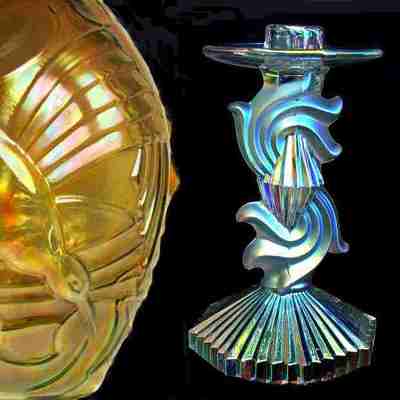The Story Behind The Glass - Josefine Wreath, Libochovice
|
If you were to drive north-westerly out of the beautiful, historical city of Prague in Czechoslovakia, on the two-hour journey to the border with Germany, you’d chance upon the little town of Libochovice when you were half way there. A pretty town situated on the River Ohre, and famed for its Baroque castle, Libochovice’s past also bears witness to the dark days of the holocaust. There was also a glassworks bearing the name of the town: Libochovice Glassworks (also called Libochowitzer Glashuette C.S., or Libochovické Sklárny) which was founded in 1912 by Josef Feigl and Vladislav Móravek. The company’s main output was container glass, although utility glass as well as blown and pressed decorative glass was also made (they had special decorating workshops). Around 20% of the company’s production was destined for export. |
Libochovice Glassworks, Czechoslovakia, in 1912 (above) and 1936 (below).
Images courtesy Libochovice Municipality. |
Top Notch Carnival Glass!
During the 1920s and early 1930s, Libochovice produced some high quality, Art Deco style glass in an interesting range of colours that included amethyst, smoke, green, blue and a colour described as “absinthe” (which we feel was almost certainly vaseline glass).
Our research into Carnival Glass made in Czechoslovakia lead us to the discovery of the Rindskopf factory, and subsequently to Libochovice Glassworks, and we were able to make contact with them before sadly, the business closed down.
They were able to confirm our discovery that they had indeed made a small amount of high quality Carnival Glass in the 1920s and 30s, including the Sublime Deco candlestick. Most probably they also made several superb Deco-style bulbous vases (Giant Lily, Inca, Pebble and Fan, and Seagulls).
Josefine Wreath: an amazing new pattern "find" by glass collector, Iris Down. All pictures are courtesy of Iris Down.
During the 1920s and early 1930s, Libochovice produced some high quality, Art Deco style glass in an interesting range of colours that included amethyst, smoke, green, blue and a colour described as “absinthe” (which we feel was almost certainly vaseline glass).
Our research into Carnival Glass made in Czechoslovakia lead us to the discovery of the Rindskopf factory, and subsequently to Libochovice Glassworks, and we were able to make contact with them before sadly, the business closed down.
They were able to confirm our discovery that they had indeed made a small amount of high quality Carnival Glass in the 1920s and 30s, including the Sublime Deco candlestick. Most probably they also made several superb Deco-style bulbous vases (Giant Lily, Inca, Pebble and Fan, and Seagulls).
Josefine Wreath: an amazing new pattern "find" by glass collector, Iris Down. All pictures are courtesy of Iris Down.
|
Fast forward to England, in Spring 2017. Iris Down was up early one Sunday to go to a car boot sale in the hope of finding something interesting. On one stall, Iris noticed some really good items, oil lamps and miners’ lamps … plus one interesting piece that was lying on the ground by the table.
She knew instantly that it was Carnival Glass and as soon as she picked it up, she felt, by the weight, that it was a fine quality piece. Iris ran her finger over something that looked like letters inside the item … and there, perfectly moulded, was the word TCHECO-SLOVAQUIE (with a hyphen, as shown below). The item has a blue base glass and a beautiful, vivid iridescence. It’s square, measuring 4½” by 4½” and standing 6” high, and it weighs 1¾ pounds.
And here’s the exciting part … we have found it in a Libochovice catalogue (from c. 1930s). A suite of shapes, mainly intended for the dressing table, but also including a sugar and creamer, were made in this beautiful pattern, that Libochovice called Josefine. Iris’s gorgeous piece is #1605, a multi-use covered jar, with a matching lid, that increased its height to 8½”. It’s highly probable that the item would also have been sold without a lid (similar to the wider #1598 in the catalogue illustration, which was probably intended as a jardinière) perhaps to be used as a posy vase or similar. Other shapes in the pattern are tray (with additional floral motifs), candlestick, four further sizes of smaller covered pots, ring holder, jardinière, creamer and sugar. Another, slightly later, Libochovice catalogue, also shows a handled basket in the same pattern. Iris added the word “Wreath” to the Libochovice name “Josefine” as a tribute to those lost in the Holocaust, especially with connections to the area. A very poignant and evocative memorial.
|
Further Significance
Carnival Glass from Czechoslovakia is almost exclusively known in marigold, particularly in press-moulded items. Three examples of the Double Tulip vase by Rindskopf are known in rare purple, but this is the first press-moulded item in blue Carnival we are aware of from Czechoslovakia.
This “find” in blue is also very significant because it adds further weight to our belief that the blow-moulded bulbous vases (Seagulls, Pebble & Fan, Inca and Giant Lily) some of which are known in blue Carnival, were also made by Libochovice.
Carnival Glass from Czechoslovakia is almost exclusively known in marigold, particularly in press-moulded items. Three examples of the Double Tulip vase by Rindskopf are known in rare purple, but this is the first press-moulded item in blue Carnival we are aware of from Czechoslovakia.
This “find” in blue is also very significant because it adds further weight to our belief that the blow-moulded bulbous vases (Seagulls, Pebble & Fan, Inca and Giant Lily) some of which are known in blue Carnival, were also made by Libochovice.
Read more about Carnival Glass from Czechoslovakia. Click on any image below.













